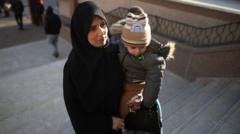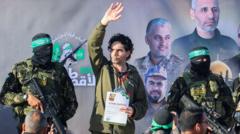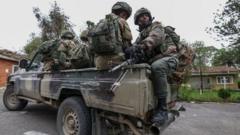In a significant turn of events, the rate of humanitarian aid entering Gaza saw a remarkable increase over the weekend, marking over 630 trucks arriving on the first day of the truce— the highest number recorded since the onset of conflict more than 15 months ago. According to United Nations representatives, this surge allows the World Food Program to deliver crucial food supplies to the stricken populace, beginning the process of addressing the severe hunger gripping the area.
Gaza Relief Efforts Intensify Amid Cease-Fire

Gaza Relief Efforts Intensify Amid Cease-Fire
As humanitarian aid dramatically increases, the fragile cease-fire raises questions about the distribution of assistance in Gaza.
The U.N., led by relief chief Tom Fletcher, reported that a majority of these trucks—over 300—were directed towards the northern regions of Gaza, which had been most deprived of essential aid, sparking concerns of impending famine among humanitarian workers. Throughout the conflict, the aid flow was limited to fewer than 100 trucks daily, hampered by stringent inspections and border closures imposed by Israel, which the country has refuted, maintaining that at least 200 trucks daily are necessary to meet the humanitarian needs for food and medical supplies.
With the cease-fire now in effect, aid deliveries into Gaza faced no issues, a stark difference from the chaos witnessed in previous months. Informing of this calm, Juliette Touma, spokesperson for the primary U.N. agency assisting Palestinians, confirmed the presence of local police ensuring the safety of the convoys as they navigated the region. Following the truce, uniformed police and armed forces were seen openly patrolling various neighborhoods, signaling Hamas's continued governance and their intention to maintain control.
Photos and videos circulating on social media illustrated the organized nature of aid deliveries, as residents observed from a distance rather than engaging in the frantic pursuit of aid that characterized earlier supply runs, which often resulted in violence amid desperation during the ongoing war.
This marked improvement in the flow of humanitarian assistance provides a glimmer of hope for the inhabitants of Gaza, while simultaneously raising pressing questions about governance and distribution integrity as the region navigates through this delicate phase.
With the cease-fire now in effect, aid deliveries into Gaza faced no issues, a stark difference from the chaos witnessed in previous months. Informing of this calm, Juliette Touma, spokesperson for the primary U.N. agency assisting Palestinians, confirmed the presence of local police ensuring the safety of the convoys as they navigated the region. Following the truce, uniformed police and armed forces were seen openly patrolling various neighborhoods, signaling Hamas's continued governance and their intention to maintain control.
Photos and videos circulating on social media illustrated the organized nature of aid deliveries, as residents observed from a distance rather than engaging in the frantic pursuit of aid that characterized earlier supply runs, which often resulted in violence amid desperation during the ongoing war.
This marked improvement in the flow of humanitarian assistance provides a glimmer of hope for the inhabitants of Gaza, while simultaneously raising pressing questions about governance and distribution integrity as the region navigates through this delicate phase.





















